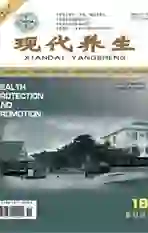供肝脂肪变性评价技术的研究进展
2024-10-23胡旭
【摘要】 肝移植现已成为治疗终末期肝病唯一有效的手段。由于供肝数量短缺和等候移植终末期肝病患者不断增多,越来越多的边缘性供肝逐渐被应用,以缓解当前供需不平衡的矛盾。与正常肝脏相比,脂肪变性供肝更容易受到冷缺血损伤,对缺血再灌注损伤也更为敏感,导致移植术后相关并发症增多。如何提高脂肪变性供肝的使用率和安全性至关重要,目前评价供肝脂肪变性的技术包括超声、CT、磁共振成像等。移植术前及术后准确评估供肝脂肪变性程度决定了供肝能否合理应用,并可为临床诊疗提供参考。
【关键词】 肝移植;脂肪变性;超声;病理
中图分类号 R617 文献标识码 A 文章编号 1671-0223(2024)19--04
Research progress on evaluation techniques for hepatic steatosis in donors Hu Xu. Zhejiang University of Traditional Chinese Medicine, Hangzhou 310053, China
【Abstract】 Liver transplantation has become the only effective treatment for end-stage liver disease. Due to the shortage of donor livers and the increasing number of patients waiting for transplantation for end-stage liver disease, more and more marginal livers are being used to alleviate the imbalance between supply and demand. Compared to normal liver, fatty liver is more susceptible to cold ischemic injury and is more sensitive to ischemia-reperfusion injury, leading to an increase in post-transplant complications. How to improve the utilization rate and safety of the steatosis donor liver is very important. At present, the techniques for evaluating the donor liver steatosis include ultrasound, CT, magnetic resonance imaging, etc. The accurate evaluation of the degree of steatosis of the donor liver before and after transplantation determines whether the donor liver can be reasonably used, and can provide reference for clinical diagnosis and treatment.
【Key words】 Liver transplantation; Steatosis; Ultrasound; Pathology
脂肪变性是供肝评价的主要方面,主要评估大泡性脂肪变性,大多数情况下大泡性脂肪变性和小泡性脂肪变性同时存在,单纯小泡性脂肪变性一般不影响移植肝的功能[1]。脂肪变性根据脂肪浸润严重程度分为轻度(<30%)、中度(30%~60%)和重度(>60%)[2]。伴有脂肪变性的移植物表现为细胞代谢受损、微循环功能障碍和肝细胞再生受损,导致合成功能恢复速度较慢,对冷缺血损伤及缺血再灌注损伤敏感性升高[3]。在临床上,小泡性脂肪变性、轻度的大泡性脂肪变性供肝可应用于肝移植,若同时存在中至重度的大泡性脂肪变,则可能会增加移植物早期功能不全、原发性移植肝无功能以及术后病死率升高的风险[4]。如何在肝移植术前准确评估供肝的脂肪变性程度是供肝质量评价的重要一环,近年来各领域针对评价供肝脂肪变性的技术也迅速发展。本文针对供肝脂肪变性评价技术的研究状况及发展趋势进行综述。
1 超声
超声是最早应用于脂肪肝评估的影像学检查方法,也是目前筛查脂肪肝的最常用方法,普通超声常用于肝脂肪变性的定性检查,而对定量检查则不敏感;受控衰减参数(controlled attenuation parameter,CAP)和超声衰减成像(attenuation imaging,ATI)均可以实现定量评估肝脏脂肪变性,其中ATI通过去除束焦点和增益补偿,计算机化肝实质区域的束衰减并获得组织的衰减系数,采集时间短,可以纳入常规超声检查,在检测不同程度的肝脂肪变性方面具有良好的诊断性能。与CAP相比,ATI技术可以将B超图像和ATI图像在超声设备的同一屏幕上显示,实现肝脏结构可视化,使操作者确定最佳测量区域的位置,提高测量精度。Bao等[5]前瞻性纳入159例非酒精性脂肪性肝病患者,1周内进行CAP、ATI检查,然后进行质子磁共振波谱检查,与CAP相比,ATI与肝脏脂肪含量的相关性较好,在预测≥10%的肝脏脂肪变性方面,ATI的诊断性能优于CAP。瞬时弹性成像也是一种可以定量肝脂肪变性的检查方法,其原理是通过仪器探头部位的振动轴发出低频率、低振幅的弹性波,弹性波在体内组织中传播的同时,探头部位的换能器进行不间断的采集超声以跟踪弹性波的传播并测量其传播速度,组织硬度和脂肪密度决定弹性波的传播速度。在测定探头上弹性波的传播速度后通过特定的算法将传播速度转化为硬度值和脂肪含量值,以此来评估肝脏脂肪变性和纤维化程度。相较于评估肝脂肪变性,临床中瞬时弹性成像更常用于评估肝纤维化,是确定慢性肝病纤维化程度的既定方法[6]。Kang等[7]对87名受试者使用超声引导衰减参数、CAP和磁共振成像基础上的质子密度脂肪分数(proton density fat fraction,PDFF)进行非酒精肝脏脂肪变性评估,以组织病理学作为金标准,该研究表明,在检测非酒精性脂肪性肝病患者的脂肪肝时,超声引导衰减参数具有较高的诊断率。与磁共振成像(magnetic resonance imaging,MRI)-PDFF相比,超声引导衰减参数具有更高的灵敏度和相似的准确性(灵敏度为86.8%比71.0%;准确度分别为75.9%和76.8%)。综上,超声检查具有无创、耗时短、成本低及良好的准确性等优势,是评价肝脂肪变性的可靠技术。
2 CT
CT平扫是判断肝脏脂肪含量的一种较好的方法。在非增强CT扫描上测量肝脏衰减适合预测病理脂肪含量[8],正常肝脏衰减程度大于脾脏,脂肪浸润使肝脏衰减程度减小,当肝脏衰减程度小于脾脏时,一般可根据肝实质衰减值、肝脾衰减比、肝脾衰减差3个指标评价肝脾CT衰减程度、肝脏脂肪浸润程度。肝脏衰减指数是平均肝密度和平均脾密度的差值,但对于<30%大泡性脂肪变性的灵敏度较低(肝脏衰减指数正常),非增强CT只在≥30%大泡性脂肪变性的定性诊断中效能较高[9-11]。
3 MRI
MRI在定量肝脏脂肪变性方面较CT更敏感,其利用某些分子的磁性检测可移动的未结合分子中的质子信号(如水、三酰甘油),但来自结构中结合的质子信号(如细胞的脂质双分子层)常规MRI则不可见,常规MRI技术使用双回波成像测量脂肪含量的准确性受到T1偏置、T2衰减以及脂肪中质子和涡流的多频信号干扰效应的限制[12-13],其他基于MRI定量检测肝脂肪变性的诊断方法包括MRI-PDFF、使用多回声化学位移磁共振或磁共振光谱,以及磁共振弹性成像等。PDFF定义为来自三酰甘油的移动质子密度与来自移动三酰甘油和移动水的质子总密度的比值。在候选活体肝供体中,多回声化学位移MRI计算出的MRI-PDFF更有利于评估供体,与活检相比,其主要优势是可以评估整个肝脏,而不是通过肝活检评估一小部分肝脏,在活体肝捐献者中,MRI-PDFF对于检测肝脂肪变性>5%具有良好的诊断效能[14],且灵敏度和特异度较高[15]。因此,MRI-PDFF具有替代肝活检的潜力[16],但由于耗时和高成本的限制,一般用于活体捐赠者的评估。
4 光学技术
高光谱成像是一种可以实现无接触和非电离方式对组织生理、形态和化学成分分析的技术[17]。高光谱成像意味着更宽的光谱范围、更高的光谱分辨率和更多的光谱通道来实现连续光谱范围成像[18],不同的组织成分有特定的吸收光谱,高光谱成像可根据所分析的组织吸收和反射率获得二维空间图像,并形成三维超立方体[19]。高光谱成像可以安全地应用于供肝静态冷保存、常温机械灌注期间和受体手术期间的肝脂肪变性评估,除定量分析肝脂肪变性外,高光谱成像还能在供肝低温机械灌注或低温携氧机械灌注期间推测出肝功能,但该技术无法区分大泡性和小泡性脂肪变性[20-22]。
5 病理组织学
病理组织学检查是目前评价供肝脂肪的金标准,通常以脂肪变性肝细胞的面积占肝组织面积的比例作为评估标准,在必要时可用油剂红27或苏丹红Ⅲ染色辅助进一步判断[23]。目前病理组织学检查依赖病理学专家在显微镜下的观察和判断,存在一定的主观性,其准确性也受到质疑[24],因此近年来结合人工智能的病理组织学检查技术不断被开发。西班牙学者开发了一种基于计算机视觉的应用程序,用于快速和自动客观地定量苏丹染色的组织病理学肝切片载玻片中的大泡脂肪变性。使用数字显微镜图像根据获得数千个特征向量,在检测过程中,这些向量被标记为脂肪液泡或非脂肪液泡,并相应地训练了一组基于不同算法的分类器。结果显示所有分类器的总体准确度均较高(>0.99),灵敏度为0.844~1,特异度>0.99[25]。有研究者设计了一种称为肝脏自适应脂肪变性分割的全自动定量检测供肝脂肪变性的算法,该方法采用混合深度学习框架,将自适应阈值的准确性与深度卷积神经网络的语义分割相结合,能够检测脂滴并识别大泡和小泡性脂肪变性,该算法在脂肪变性定量方面的准确率为97.27%(平均误差1.07%,最大平均误差5.62%),并且该算法速度快(平均计算时间为0.72s),为自动化定量和实时肝移植评估提供了依据[26]。有学者通过高像素的智能手机代替光学显微镜为供肝病理检查提供技术支持[27],智能手机捕获冷冻切片肝脏组织载玻片的图像与数字算法结合来测量脂肪变性,与不同经验的病理学家提供的脂肪变性评分进行比较,均获得可靠的准确性及特异性[28-29]。
6 小结
肝脂肪变性与肥胖、饮酒、糖尿病和代谢性疾病有关,脂肪变性肝移植目前是扩大标准供肝移植中最大的一部分,鉴于全球肥胖的日益流行,脂肪变性供体的数量预计还会上升。随着检查技术的提升,可实现快速、精准、无创的方式确定供肝脂肪变性程度,影像学方面,超声检查因其便捷性及准确性可能在未来成为主要评估方式,MRI检查在活体肝移植的供肝质量评价中会承担更重要的角色,组织病理学检查目前尚不能被取代,仍是当前评估脂肪变性的金标准。但随着人工智能的发展,病理学家的需求可能会逐渐削弱,病理组织学检查也会更具客观性。
7 参考文献
[1] Han S,Ha SY,Park CK,et al.Microsteatosis may not interact with macrosteatosis in living donor liver transplantation[J].J Hepatol,2015,62(3):556-562.
[2] Kleiner DE,Brunt EM,Van Natta M,et al.Design and validation of a histological scoring system for nonalcoholic fatty liver disease[J].Hepatology,2005,41(6):1313-1321.
[3] 杨汉文,王强,成柯,等.脂肪变性供肝冷缺血损伤的研究进展[J].器官移植.2023,14(3):449-454.
[4] 吴小雅,江艺.供肝脂肪变性程度对肝移植术后恢复的影响[J/CD].实用器官移植电子杂志,2023,11(2):187-92.
[5] Bao J,Lv Y,Wang K,et al.A comparative study of ultrasound attenuation imaging, controlled attenuation parameters, and magnetic resonance spectroscopy for the detection of hepatic steatosis[J].J Ultrasound Med,2022,42(7):1481-1489.
[6] Dietrich CF,Bamber J,Berzigotti A,et al.EFSUMB guidelines and recommendations on the clinical use of liver ultrasound elastography, update 2017 (long version)[J].Ultraschall Med,2017,38(4):e48-52.
[7] Kang KA,Lee SR,Jun DW,et al.Diagnostic performance of a novel ultrasound-based quantitative method to assess liver steatosis in histologically identified nonalcoholic fatty liver disease[J].Med Ultrason,2023,25(1):7-13.
[8] Kodama Y,Ng CS,Wu TT,et al.Comparison of CT methods for determining the fat content of the liver[J].AJR Am J Roentgenol,2007,188(5):1307-1312.
[9] Park SH,Kim PN,Kim KW,et al.Macrovesicular hepatic steatosis in living liver donors:Use of CT for quantitative and qualitative assessment [J].Radiology,2006,239(1):105-112.
[10] Lee SW,Park SH,Kim KW,et al.Unenhanced CT for assessment of macrovesicular hepatic steatosis in living liver donors:Comparison of visual grading with liver attenuation index[J].Radiology,2007,244(2):479-485.
[11] Byun J,Lee SS,Sung YS,et al.CT indices for the diagnosis of hepatic steatosis using non-enhanced CT images:Development and validation of diagnostic cut-off values in a large cohort with pathological reference standard[J].Eur Radiol,2019,29(8):4427-4435.
[12] Dioguardi Burgio M,Bruno O,Agnello F,et al.The cheating liver:Imaging of focal steatosis and fatty sparing[J].Expert Rev Gastroenterol Hepatol,2016,10(6):671-678.
[13] Zheng D,Guo Z,Schroder PM,et al.Accuracy of MR imaging and MR spectroscopy for detection and quantification of hepatic steatosis in living liver donors:A Meta-analysis[J].Radiology,2017,282(1):92-102.
[14] Bae JS,Lee DH,Suh KS,et al.Noninvasive assessment of hepatic steatosis using a pathologic reference standard:Comparison of CT, MRI, and US-based techniques[J].Ultrasonography,2022,41(2):344-354.
[15] Gu J,Liu S,Du S,et al.Diagnostic value of MRI-PDFF for hepatic steatosis in patients with non-alcoholic fatty liver disease: A Meta-analysis[J].Eur Radiol,2019,29(7):3564-3573.
[16] Qi Q,Weinstock AK,Chupetlovska K,et al.Magnetic resonance imaging-derived proton density fat fraction (MRI-PDFF) is a viable alternative to liver biopsy for steatosis quantification in living liver donor transplantation[J].Clin Transplantat,2021,35(7):e14339-14332.
[17] Lu G,Fei B.Medical hyperspectral imaging:A review[J].J Biomed Opt,2014,19(1):10901.
[18] Karim S,Qadir A,Farooq U,et al.Hyperspectral imaging:a review and trends towards medical imaging[J].Curr Med Imaging,2022,19(5):417-427.
[19] Kulcke A,Holmer A,Wahl P,et al.A compact hyperspectral camera for measurement of perfusion parameters in medicine[J].Biomed Tech (Berl), 2018,63(5):519-527.
[20] Kneifel F,Wagner T,Flammang I,et al.Hyperspectral imaging for viability assessment of human liver allografts during normothermic machine perfusion[J].Transplant Direct,2022,8(12):e1420.
[21] Fodor M,Lanser L,Hofmann J,et al.Hyperspectral imaging as a tool for viability assessment during normothermic machine perfusion of human livers:A proof of concept pilot study[J].Transpl Int,2022,35:10355.
[22] Wagner T,Katou S,Wahl P,et al.Hyperspectral imaging for quantitative assessment of hepatic steatosis in human liver allografts [J].Clin Transplant,2022,36(8):e14736.
[23] Riva G,Villanova M,Cima L,et al.Oil red O is a useful tool to assess donor liver steatosis on frozen sections during transplantation[J].Transplant Proc,2018,50(10):3539-3543.
[24] El-Badry AM,Breitenstein S,Jochum W,et al.Assessment of hepatic steatosis by expert pathologists:The end of a gold standard[J].Ann Surg,2009,250(5):691-697.
[25] Pérez-Sanz F,Riquelme-Pérez M,Martínez-Barba E,et al.Efficiency of machine learning algorithms for the determination of macrovesicular steatosis in frozen sections stained with sudan to evaluate the quality of the graft in liver transplantation[J].Sensors (Basel),2021,21(6):1993.
[26] Salvi M,Molinaro L,Metovic J,et al.Fully automated quantitative assessment of hepatic steatosis in liver transplants[J].Comput Biol Med,2020,123:103836.
[27] Cesaretti M,Gal J,Bouveyron C,et al.Accurate assessment of nonalcoholic fatty liver disease lesions in liver allograft biopsies by a smartphone platform:A proof of concept[J].Microsc Res Tech,2020,83(9):1025-1031.
[28] Xu K,Raigani S,Shih A,et al.A novel digital algorithm for identifying liver steatosis using smartphone-captured images[J].Transplant Direct,2022,8(9):e1361.
[29] Cherchi V,Mea VD,Terrosu G,et al.Assessment of hepatic steatosis based on needle biopsy images from deceased donor livers[J].Clin Transplant,2022,36(3):e14557.
[2024-05-15收稿]
作者单位:310053 浙江省杭州市,浙江中医药大学
